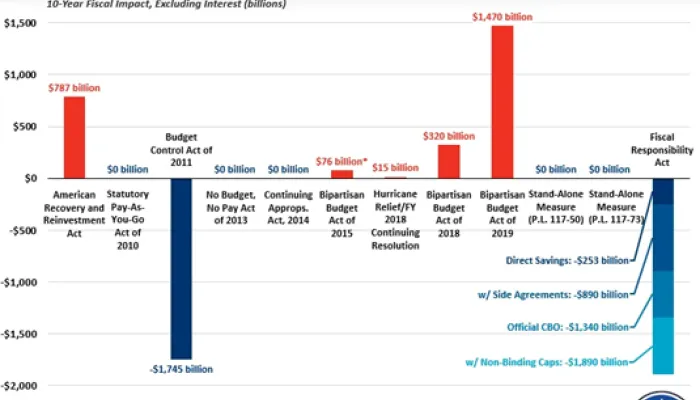With Debt Limit Reinstated, It's Time for Reform
As lawmakers go to conference for the tax bill, an important issue has flown under the radar. The debt limit was reinstated on December 9 after the Treasury Department opted to use accounting tools called “extraordinary measures” to avoid breaching the debt limit. The Bipartisan Policy Center (BPC) estimates that there are currently $270 billion in available extraordinary measures. The Congressional Budget Office (CBO) projected that extraordinary measures will run out by late March or early April of 2018. BPC has a slightly less optimistic estimate, forecasting that date will arrive in March 2018. In addition to raising the debt limit, lawmakers should certainly put in place reforms to make the budget and budget process more responsible.
Both CBO and BPC assume no change to current law, but tax cuts or spending increases in year-end legislation could push up the debt enough to move up the date. As usual, the pace of tax collections could also alter the deadline. The uncertainty around the actual deadline means that lawmakers should raise the debt ceiling sooner rather than later, especially because it could cause short-term interest rates to rise.
Previous increases in the debt limit have often been accompanied by reforms to improve fiscal discipline or have been part of legislation reducing the deficit. The need to increase the debt limit next year could also be an opportunity to reform the process for considering the debt limit to make it a more effective tool for fiscal discipline and avoid brinksmanship.
Earlier this year, Maya MacGuineas, President of the Committee for a Responsible Federal Budget, explained in a Washington Post op-ed why the statutory debt limit– one of the few checks on borrowing – needs reform, given the country’s acute and chronic fiscal challenges. In 2015, we published a paper through our Better Budget Process Initiative outlining possible reforms to the debt limit.
These recommendations include:
Linking changes in the debt limit to achieving responsible fiscal targets
1) Providing presidential authority to increase the debt limit if fiscal targets are met.
2) Providing presidential authority to increase the debt limit when the authorization is accompanied by a plan to put debt on a declining path as a share of Gross Domestic Product (GDP).
3) Suspending the statutory limit on debt if long-term fiscal targets are met.
Incorporating the debt limit into Congress’s fiscal decision making
4) Automatically increasing the debt limit upon passage of a budget resolution.
5) Requiring reconciliation instructions to increase the debt limit to accommodate debt levels in the budget resolution.
6) Requiring legislation with significant net costs to include an increase in the debt limit.
Applying the debt limit to more economically meaningful measures
7) Modifying the debt limit to apply only to debt held by the public.
8) Indexing the debt limit to GDP growth, effectively capping debt-to-GDP.
Replacing the debt limit with a limit on future obligations
9) Applying the debt limit to future liabilities and unfunded obligations.
10) Replacing the debt limit with a “debt cap.”
These suggestions would improve the debt limit by making it a more meaningful measure of our ability to deal with our debt, increasing accountability, creating incentives for policymakers to enact fiscally responsible legislation before debt is incurred, and curbing irresponsible brinksmanship in debt limit debates.
As policymakers confront the debt limit in the near future, we hope they consider these options to make the process less painful and more productive. As our paper concludes:
There are numerous options for reforming the debt limit which reduce the risk of a default while providing both carrots and sticks to encourage fiscal responsibility and providing greater accountability in the budget process. Reforms of the debt limit could also make the debt limit a more meaningful measure of our fiscal condition and create a greater link between the debt limit and the policy decisions affecting the debt.
Click here to read more about the federal debt limit.


